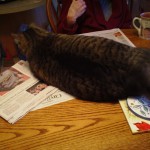Learning to write for publication is often a long road, and self-editing is definitely a process. Yet as I tell my students, there are some specific things any writer can do to rewrite for clarity and readability.
Writing Tip for Today: Even seasoned writers (like me!) get complacent, forgetting some of these basic self-editing techniques. No matter where you’re at on the writing journey the following five self-editing tools can be a quick way to take your writing to that “next level.”
- Work on your verbs. While I don’t recommend self-conscious writing, strengthening your verbs in general helps the reader see a more particular picture. Seek out and employ verbs which help you as writer manage your reader. A sure sign of weak verbs is the use of many “to be” forms, and passive constructions. EX: The minutes were read by Nancy.
- Work on the use of was “ing” words. Gerund constructions (ing words) slow the prose. While you may sometimes use an “ing” to denote a continual motion, most of the time you’re better off use a simple past tense verb. EX: He was hanging around. He hung around.
- Work on your modifiers. I know, your elementary school teacher encouraged you to write “descriptively.” But take a look at your work. Are you using a lot of modifiers when you could find a concrete noun? Try taking out every modifier (adjectives and adverbs) and reread the work.
- Work on your prepositions. Do you begin sentences with prepositions such as “as?” This is often a sign of weak writing. Readers can process only one action at a time, so you gain little by trying to make the reader see more. Also, be sure you aren’t stringing together prepositional phrases that go around, over, under and through. The reader will get lost.
- Work on your transitions. A transition signals the reader that we are in a different time and/or place than the scene or passage which came before. Any time readers aren’t sure when and where they are in a story, they tend to lose interest. Keep your transitions simple, such as “one day,” or “by that fall.” I like to place my time and place nearest the beginning of a sentence to orient my reader immediately.





Excellent tips, linda